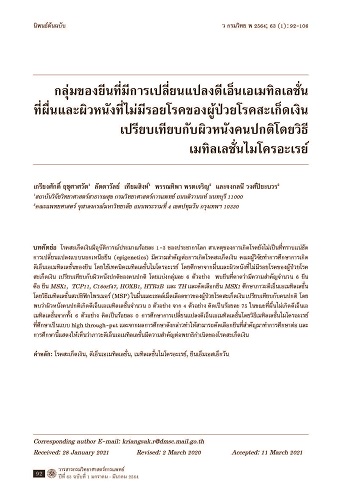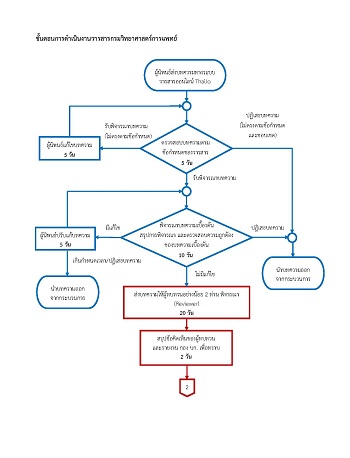Global DNA Methylated Gene of Involved Skin and Uninvolved Skin of Psoriasis Compared with Normal Skin by Methylation Microarray
Keywords:
Psoriasis, DNA methylation, Methylation microarray, MSX1Abstract
Psoriasis is approximately 1-3% of the population worldwide. Etiology of the disease is still unclear. Recently, epigenetic phenomena have also been implicated in the pathogenesis of psoriasis. We investigated DNA methylation by methylation microarray in tissue from 6 involved skins and uninvolved skins of chronic plaque type psoriasis patients compared to 6 normal skins from healthy controls. There are 6 candidate genes MSX1, TCP11, C16orf47, HOXB1, HTR3B and TH. MSX1 gene was selected from methylation microarray data and was analyzed DNA methylation correlated with genes expression in keratinocytes and peripheral blood mononuclear cells (PBMC) compared between psoriasis and normal controls, using methylation specifi c primer (MSP). DNA methylation occurred in three of four samples of normal skins, accounting for 75%. Whereas DNA methylation from 6 of all 6 involved skin samples were represented 0%. In conclusion, the present study is the fi rst study using high through-put technique (methylation microarray) to investigate DNA methylation in psoriasis. The result of methylation microarray could indicate the signifi cant the candidate genes for further studying in psoriasis. Moreover, this study demonstrated DNA methylation plays an important role in pathogenesis and course of psoriasis
References
Nickoloff BJ, Nestle FO. Recent insights into the immunopathogenesis of psoriasis provide new therapeutic opportunities. J Clin Invest 2004; 113(12): 1664-75.
Christophers E. Psoriasis--epidemiology and clinical spectrum. Clin Exp Dermatol 2001; 26(4): 314-20.
Raychaudhuri SP, Farber EM. The prevalence of psoriasis in the world. J Eur Acad Dermatol Venereol 2001; 15(1): 16-7.
Bowcock AM, Krueger JG. Getting under the skin: the immunogenetics of psoriasis. Nat Rev Immunol 2005; 5(9): 699-711.
Schön MP, Boehncke WH. Psoriasis. N Engl J Med 2005; 352(18): 1899-912.
Nickoloff BJ, Qin JZ, Nestle FO. Immunopathogenesis of psoriasis. Clin Rev Allergy Immunol 2007; 33(1-2): 45-56.
Egger G, Liang G, Aparicio A, Jones PA. Epigenetics in human disease and prospects for epigenetic therapy. Nature 2004; 429(6990): 457-63.
Robertson KD. DNA methylation and human disease. Nat Rev Genet 2005; 6(8): 597-610.
Rodenhiser D, Mann M. Epigenetics and human disease: translating basic biology into clinical applications. CMAJ 2006; 174(3): 341-8.
Ruchusatsawat K, Wongpiyabovorn J, Shuangshoti S, Hirankarn N, Mutirangura A. SHP-1 promoter 2 methylation in normal epithelial tissues and demethylation in psoriasis. J Mol Med (Berl) 2006; 84(2): 175-82.
Brown SE, Fraga MF, Weaver IC, Berdasco M, Szyf M. Variations in DNA methylation patterns during the cell cycle of HeLa cells. Epigenetics 2007; 2(1): 54-65.
Shen L, Kondo Y, Guo Y, Zhang J, Zhang L, Ahmed S, et al. Genome-wide profiling of DNA methylation reveals a class of normally methylated CpG island promoters. PLoS Genet 2007; 3(10): 2023-36.
Bock C, Paulsen M, Tierling S, Mikeska T, Lengauer T, Walter J. CpG island methylation in human lymphocytes is highly correlated with DNA sequence, repeats, and predicted DNA structure. PLoS Genet 2006; 2(3): e26. (10 pages).
Yu YP, Paranjpe S, Nelson J, Finkelstein S, Ren B, Kokkinakis D, et al. High throughput screening of methylation status of genes in prostate cancer using an oligonucleotide methylation array. Carcinogenesis 2005; 26(2): 471-9.
Rauch T, Li H, Wu X, Pfeifer GP. MIRA-assisted microarray analysis, a new technology for the determination of DNA methylation patterns, identifies frequent methylation of homeodomain-containing genes in lung cancer cells. Cancer Res 2006; 66(16): 7939-47.
Miletich I, Sharpe PT. Normal and abnormal dental development. Hum Mol Genet 2003; 12 Spec No 1: R69-73.
Wanichnopparat W, Suwanwongse K, Pin-on P, Aporntewan C, Mutirangura A. Genes associated with the cis-regulatory functions of intragenic LINE-1 elements. BMC Genomics 2013; 14(1): 205.
Weisenberger DJ, Trinh BN, Campan M, Sharma S, Long TI, Ananthnarayan S, et al. DNA methylation analysis by digital bisulfite genomic sequencing and digital MethyLight. Nucleic Acids Res 2008; 36(14): 4689-98.
Naumova OY, Lee M, Koposov R, Szyf M, Dozier M, Grigorenko EL. Differential patterns of whole-genome DNA methylation in institutionalized children and children raised by their biological parents. Dev Psychopathol 2012; 24(1): 143-55.
Zhang P, Zhao M, Liang G, Yin G, Huang D, Su F, et al. Whole-genome DNA methylation in skin lesions from patients with psoriasis vulgaris. J Autoimmun 2013; 41: 17-24.
Bai J, Liu Z, Xu Z, Ke F, Zhang L, Zhu H, et al. Epigenetic downregulation of SFRP4 contributes to epidermal hyperplasia in psoriasis. J Immunol 2015; 194(9): 4185-98.
Verma D, Ekman AK, Bivik Eding C, Enerbäck C. Genome-wide DNA methylation profiling identifies differential methylation in uninvolved psoriatic epidermis. J Invest Dermatol 2018; 138(5): 1088-93.
Ruchusatsawat K, Wongpiyabovorn J, Protjaroen P, Chaipipat M, Shuangshoti S, Thorner PS, et al. Parakeratosis in skin is associated with loss of inhibitor of differentiation 4 via promoter methylation. Hum Pathol 2011; 42(12): 1878-87.
Ruchusatsawat K, Thiemsing L, Mutirangura A, Wongpiyabovorn J. BCAP 31 expression and promoter demethylation in psoriasis. Asian Pac J Allergy Immunol 2017; 35(2): 86-90.
Johnson-Huang LM, Suárez-Fariñas M, Pierson KC, Fuentes-Duculan J, Cueto I, Lentini T, et al. A single intradermal injection of IFN-γ induces an inflammatory state in both non-lesional psoriatic and healthy skin. J Invest Dermatol 2012; 132(4): 1177-87.
Alappat S, Zhang ZY, Chen YP. Msx homeobox gene family and craniofacial development. Cell Res 2003; 13(6): 429-42.
Dunwell TL, Hesson LB, Pavlova TV, Zabarovska V, Kashuba VI, Catchpoole D, et al. Epigenetic analysis of childhood acute lymphoblastic leukemia. Epigenetics 2009; 4(3): 185-93.




